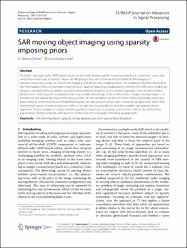| dc.contributor.author | Özben Önhon, Naime | |
| dc.contributor.author | Çetin, Müjdat | |
| dc.date.accessioned | 2021-01-08T21:51:26Z | |
| dc.date.available | 2021-01-08T21:51:26Z | |
| dc.date.issued | 2017 | |
| dc.identifier.issn | 1687-6180 | |
| dc.identifier.uri | http://doi.org/10.1186/s13634-016-0442-z | |
| dc.identifier.uri | https://hdl.handle.net/20.500.12846/255 | |
| dc.description | Cetin, Mujdat/0000-0002-9824-1229 | en_US |
| dc.description | WOS:000393699200001 | en_US |
| dc.description.abstract | Synthetic aperture radar (SAR) returns from a scene with motion can be viewed as data from a stationary scene, but with phase errors due to motion. Based on this perspective, we formulate the problem of SAR imaging of motion-containing scenes as one of joint imaging and phase error compensation. The proposed method is based on the minimization of a cost function which involves sparsity-imposing regularization terms on the reflectivity field to be imaged, considering that it admits a sparse representation as well as on the spatial structure of the motion-related phase errors, reflecting the assumption that only a small percentage of the entire scene contains moving objects. To incorporate the spatial structure of the phase errors into the problem, we provide three different sparsity-enforcing prior terms. In order to achieve computational gains, we also present a two-step version of our approach, which first determines regions of interest that are likely to contain the moving objects and then applies our sparsity-driven approach for joint image reconstruction and autofocusing in such a spatially constrained setting. Our preliminary experiments demonstrate the effectiveness of this new moving target SAR imaging approach. | en_US |
| dc.description.sponsorship | Scientific and Technological Research Council of TurkeyTurkiye Bilimsel ve Teknolojik Arastirma Kurumu (TUBITAK) [105E090]; Turkish Academy of Sciences Distinguished Young Scientist AwardTurkish Academy of Sciences | en_US |
| dc.description.sponsorship | This work was partially supported by the Scientific and Technological Research Council of Turkey under Grant 105E090, and by a Turkish Academy of Sciences Distinguished Young Scientist Award. | en_US |
| dc.language.iso | eng | en_US |
| dc.publisher | Springer | en_US |
| dc.rights | info:eu-repo/semantics/openAccess | en_US |
| dc.subject | Sar | en_US |
| dc.subject | Moving Object | en_US |
| dc.subject | Sparsity | en_US |
| dc.subject | Group Sparsity | en_US |
| dc.subject | Low-Rank Sparse Decomposition | en_US |
| dc.title | SAR moving object imaging using sparsity imposing priors | en_US |
| dc.type | article | en_US |
| dc.relation.journal | Eurasip Journal On Advances In Signal Processing | en_US |
| dc.relation.publicationcategory | Makale - Uluslararası Hakemli Dergi - Kurum Öğretim Elemanı | en_US |
| dc.contributor.department | TAÜ, Mühendislik Fakültesi, Elektrik-Elektronik Mühendisliği Bölümü | en_US |
| dc.contributor.institutionauthor | Özben Önhon, Naime | |
| dc.identifier.doi | 10.1186/s13634-016-0442-z | |
| dc.identifier.wosquality | Q3 | en_US |
| dc.identifier.scopusquality | Q2 | en_US |
| dc.identifier.wos | WOS:000393699200001 | en_US |

















